The Isle of Skye is one of the most popular places to visit in Scotland. It’s a beautiful island with plenty of things to do, but most of the lists and information you’ll find mention the same few things.
Skye has a small population of around 13,000 but attracts over 650,000 visitors throughout the year, many of them during the peak season from May to September. This means that some of the most popular things to do in Skye can be very busy during that time.
That doesn’t mean you shouldn’t visit them, but knowing a bit more about the top things to do in Skye and what to expect there will help you plan your trip.
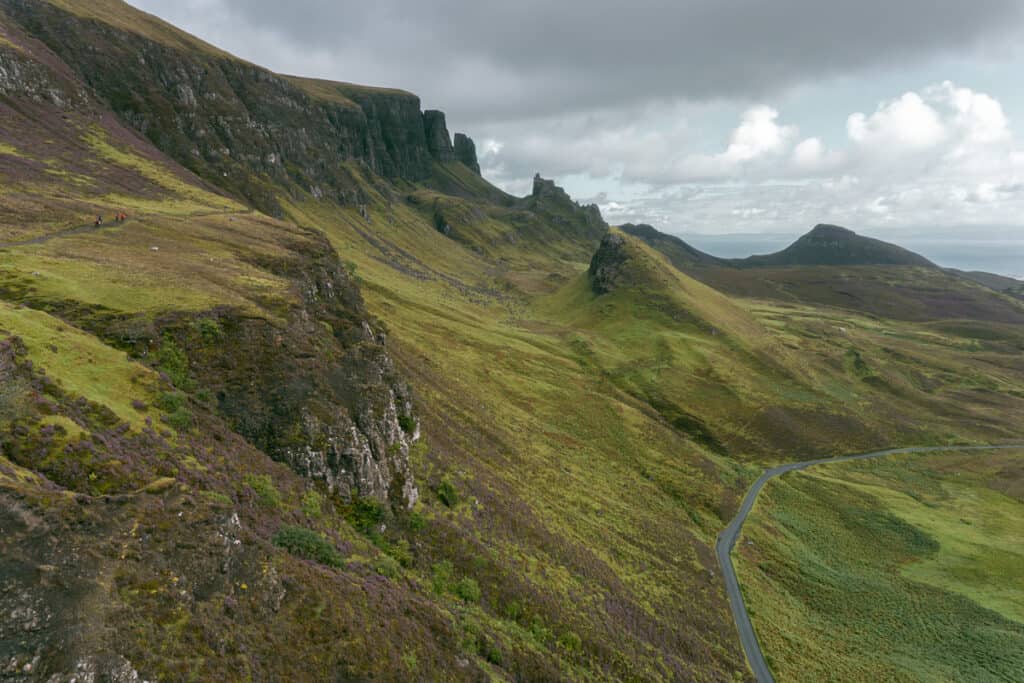
Choose the things you want to see the most from below, then use my guide on how to find more unique things to do in Skye and you’ll have a fantastic trip combining popular sites with lesser-known places to visit.
There are so many beautiful and wonderful things to do in the Isle of Skye, but they are by no means the ONLY things to do. I’m going to go out on a limb and say that if you did NONE of these top things to do, you would still have an amazing trip, but I know they are popular for a reason and are why a lot of people want to visit Skye.
So, while I’m going to list what those things are, it doesn’t mean this is a checklist that must be completed. Instead, consider what YOU want out of your trip to Skye, what will make you happy with your visit, and then plan accordingly.
You might hear things about the “Top 5 Things to Do” on Skye, which is what I actually intended this post to be, but when it came to actually writing it I realised there were slight variations on this which meant it could be longer, and there were a couple of other debatably popular attractions too. So here we are with 12!
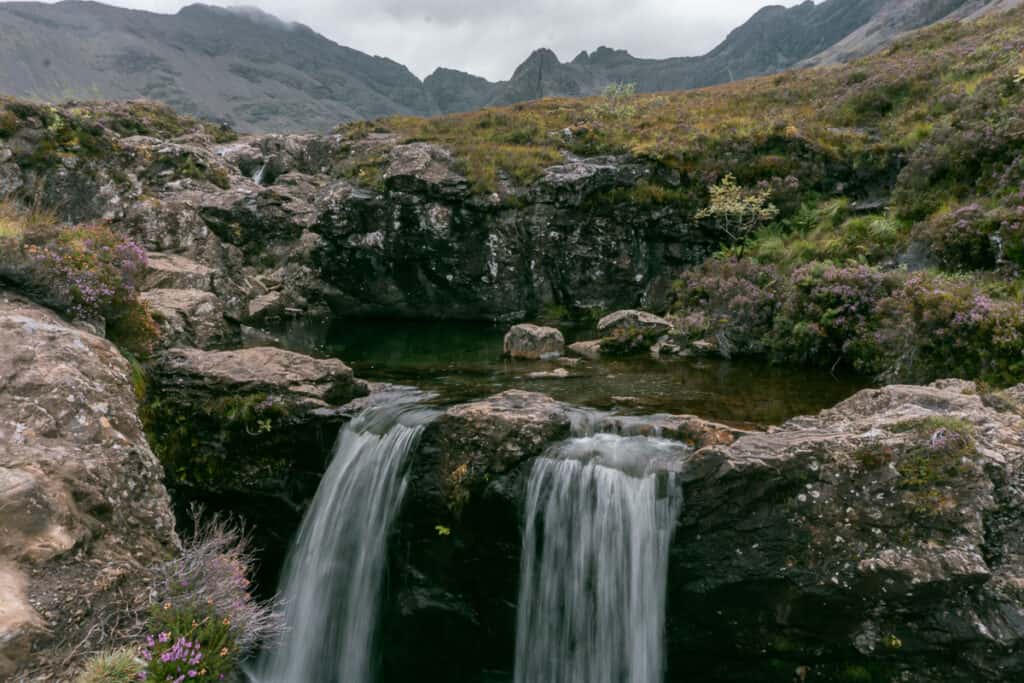
1. The Old Man of Storr
Location: Located on the Trotternish Ridge, north of Portree.
The Old Man of Storr is one of the Isle of Skye’s most iconic and photographed landmarks. It is part of the Trotternish Ridge which was formed by a massive ancient landslide. This part, in particular, includes the Old Man of Storr, a towering rock pinnacle which stands apart from the rest of the ridge.
The hike to the Old Man of Storr offers panoramic views over the Sound of Raasay and the surrounding countryside. It’s especially popular at sunrise and sunset when the light enhances the beauty of the rock formations.
The Old Man of Storr is steeped in local legend and is said to be the thumb of a giant who was buried there.
Historically, this area was also used by locals for grazing sheep and the trail itself was once part of old shepherd paths.
Hike Details: The main hike to the Old Man of Storr is about 3.8 km (2.4 miles) round trip, with a moderate difficulty level due to some steep and rocky sections. The trail is well-marked but can be muddy or slippery in wet weather, so sturdy footwear is recommended.
Facilities: At the beginning of the trail, there is a pay-and-display car park. It costs £6 per car for up to 6 hours’ stay and £7 for up to 12 hours, and it can be paid by coins or contactless card. There are restroom facilities available there. Across the road is a small takeaway coffee shop with a customer car park.
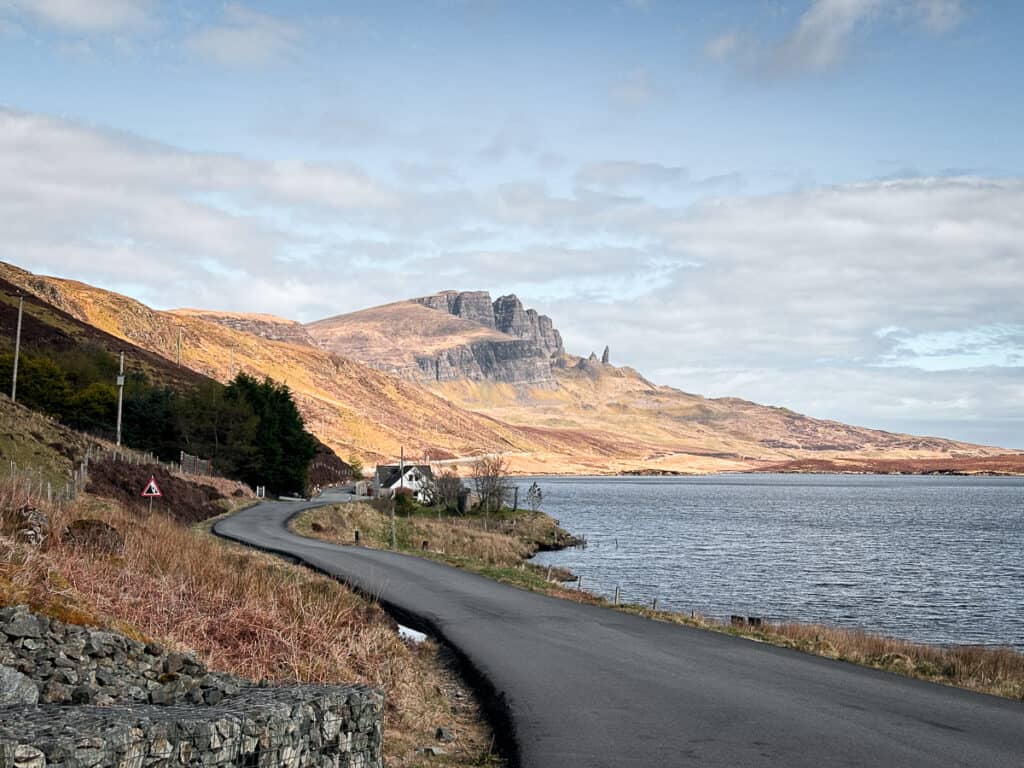
2. The Fairy Pools
Location: Situated in Glen Brittle, on the west coast of the Isle of Skye.
The Fairy Pools are renowned for their ethereal beauty and clear blue waters. These natural pools and waterfalls offer a magical setting for walking, photography, and even swimming if you want to brave the cold water.
The area is surrounded by the stunning peaks of the Cuillin Hills, making it a picturesque spot, as long as the cloud isn’t low and covering them like the first time I went!
The vibrant colours of the pools are most striking on a sunny day, but they also hold a mystical charm under overcast skies.
Contrary to popular belief, the name “Fairy Pools” was invented thanks to the colour of the water and is not from local folklore, although Skye does have an association with fairies, and there are many fairy stories linked to the island.
Historically, the area was far less magical and was instead the site of clan battles, with the pools and river valleys often serving as battlegrounds for the MacLeod and MacDonald clans.
Unfortunately, the Fairy Pools have been a bit of a victim of social media in that there are often over-saturated and unrealistic photos of them, which can lead to people’s expectations not being met when they visit. You may not be able to see the colour of the water as well as you have been in photos, and the amount of water coming down depends on how rainy it has been.
It’s still a beautiful spot, though, and a pleasant walk!
The drive down to Glenbrittle can get very busy with cars, so allow plenty of time to get there. As you get closer to the pools, the passing places get smaller, so don’t get into a line of too many cars.
Hike Details: The walk to the Fairy Pools is around 2.4 km (1.5 miles) round trip and is fairly easy other than the steep section at the beginning/end. The trail is relatively flat after that, and you can turn back whenever you want to.
Facilities: A pay-and-display car park is available across the road from the trail’s start. You can pay with coins or a contactless card. The cost is £5. There are also restroom facilities and water for drink bottles and pets. It is a manned car park, and turnover is fairly good as it’s a shorter walk, although it is sometimes closed when it’s full.
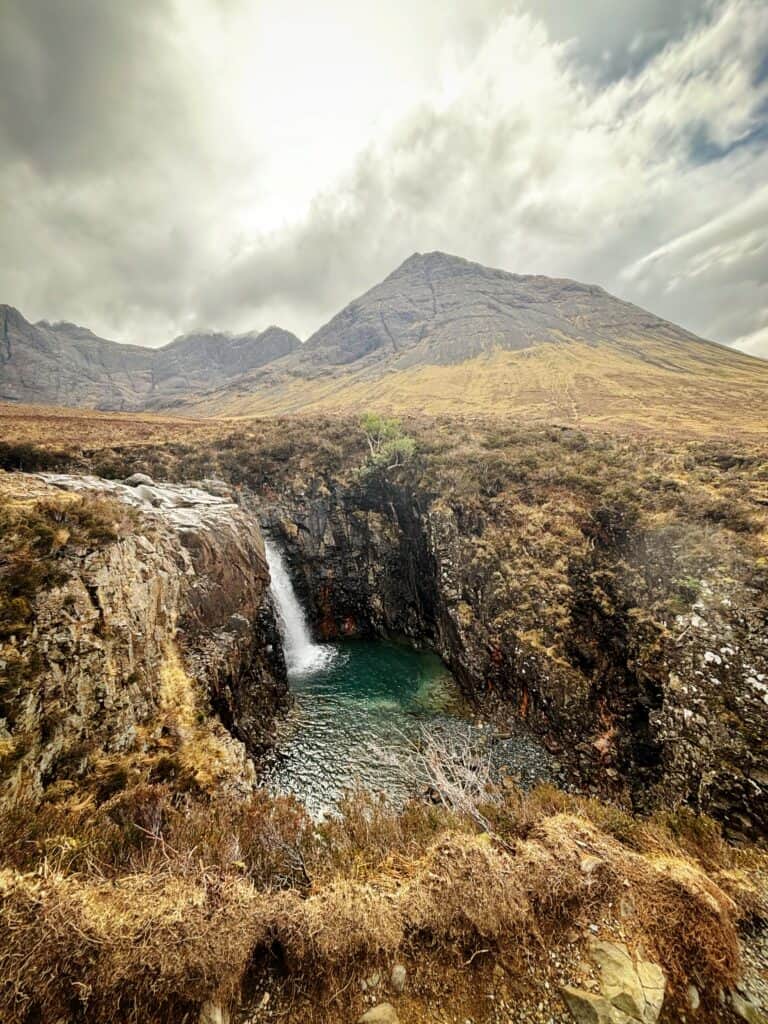
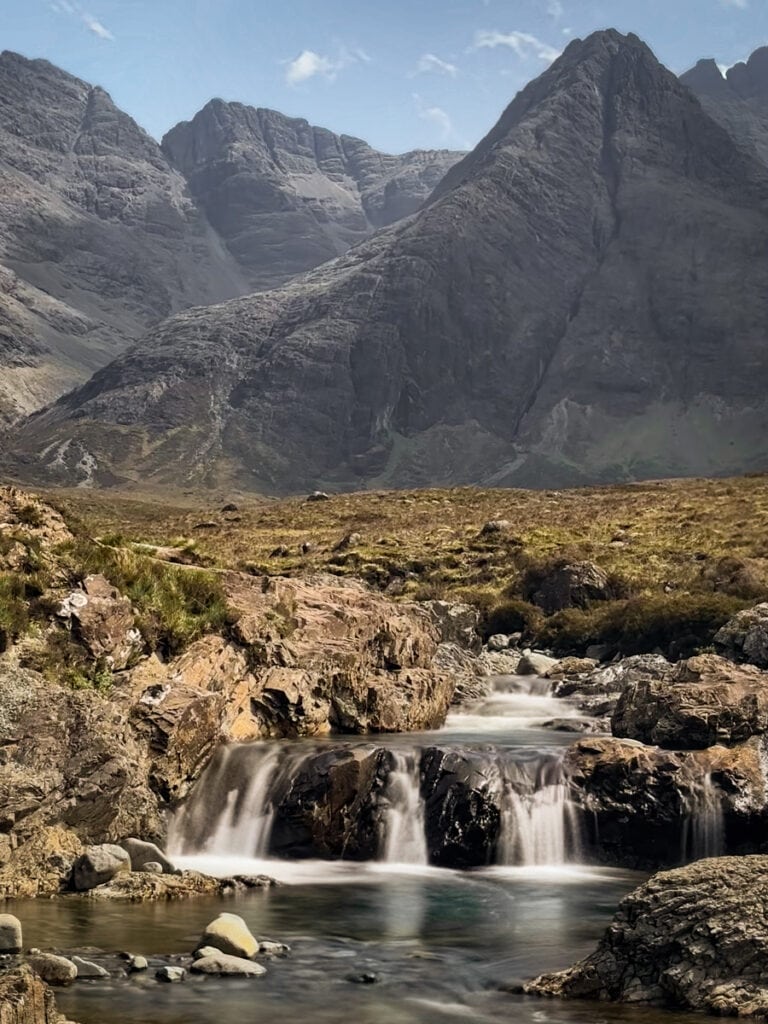
3. The Quiraing
Location: Located on the eastern face of Meall na Suiramach, near the village of Staffin.
The Quiraing is part of a massive landslip on the eastern face of Meall na Suiramach, creating some of the most dramatic and unusual landscapes on Skye. The area is characterized by its striking rock formations, cliffs, and plateaus, making it a favourite spot for hikers and photographers.
The hike offers stunning views of the surrounding countryside and coastline, with several vantage points along the way.
You can just make your way to a viewing point close to the car park and not embark on the hike, but doing the loop gives you a different perspective on the area and allows you to see some of the unique rock formations up close.
The Quiraing is also rich in folklore, with many legends associated with its unique geological features. The area has been used as a filming location for several movies and TV shows, adding to its allure.
Historically, the Quiraing has been a place of refuge; during times of conflict, livestock were hidden in the Quiraing to keep them safe from Viking raiders. This natural fortification allowed the local clans to protect their resources and livestock from marauding forces.
Hike Details: The circular hike is about 6.8 km (4.2 miles) long and is of moderate to difficult difficulty due to some steep and uneven sections. The path is currently being upgraded to help with this.
The trail can be challenging, especially in wet conditions, so proper hiking boots and gear are essential. The hike takes you through a variety of landscapes, including grassy slopes, rocky outcrops, and narrow paths along cliff edges.
Facilities: There is a car park on the single-track road between Staffin and Uig, at the point where the Quiraing hike starts. It costs £6, and you can use the Ringo App.
It gets very busy as many people just stop for a quick photo opportunity, and others do the full hike.
In the summer, a food truck is located at the car park itself, but the nearest restroom facilities are in the village of Staffin at the community hall, and there are also a couple of cafes there.
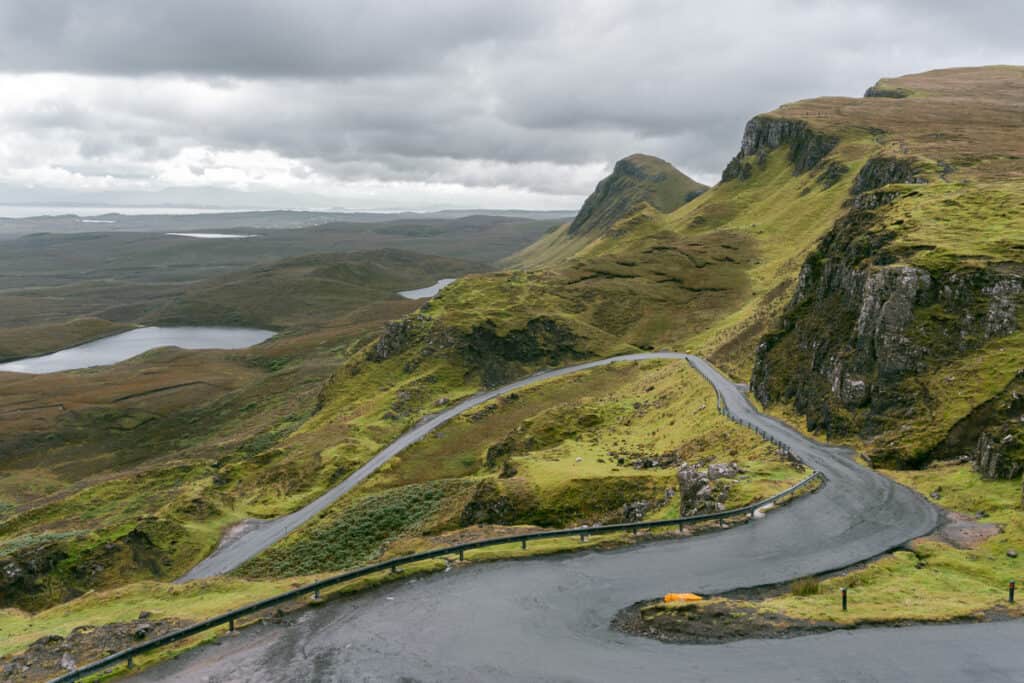
4. The Fairy Glen (Bail nan cnoc in Gaelic)
Location: Located near the village of Uig in the northern part of the Isle of Skye.
The Fairy Glen near Uig is a whimsical and enchanting landscape that looks like something out of a fantasy novel with its small, conical hills and peculiar rock formations, including Castle Ewen, which resembles a crumbling medieval forest.
Despite its fairy-tale-like appearance, the landscape is the result of geological processes, with the unique formations created by landslips and erosion over centuries. Some have called it the “Mini Quiraring”.
However, the real name for the area is Balnaknock, or Bail nan cnoc in Scottish Gaelic, which means village in the hills.
While that could suggest that this may have been a fairy village, as fairy villages are often said to be found in areas with small lochans and hills, there are no traceable tales associated with this particular spot.
The reality is that the Fairy Glen is a modern name for this area, the same as the Fairy Pools, likely dreamed up by those who were taken in by the magical beauty of the landscape and sought to associate it with other fairy legends of Skye.
The surreal landscape became very popular in recent years, and a car park and trails have now been created there in an effort to preserve the area’s flora and fauna and discourage further erosion and damage.
Unfortunately, its fairy association also means a flat area of land just below Castle Ewen has often had a stone spiral on it, left by people moving rocks around to form it. No one knows quite when it was started, but it has left permanent marks on the ground. It’s often removed and there are signs not to walk or place rocks there that are unfortunately ignored. Please don’t do this!
Facilities: Limited pay-and-display parking is available. It is a single-track road with nowhere else to park, so be aware you may need to return another time if it’s full. The nearest public restrooms are in Uig.
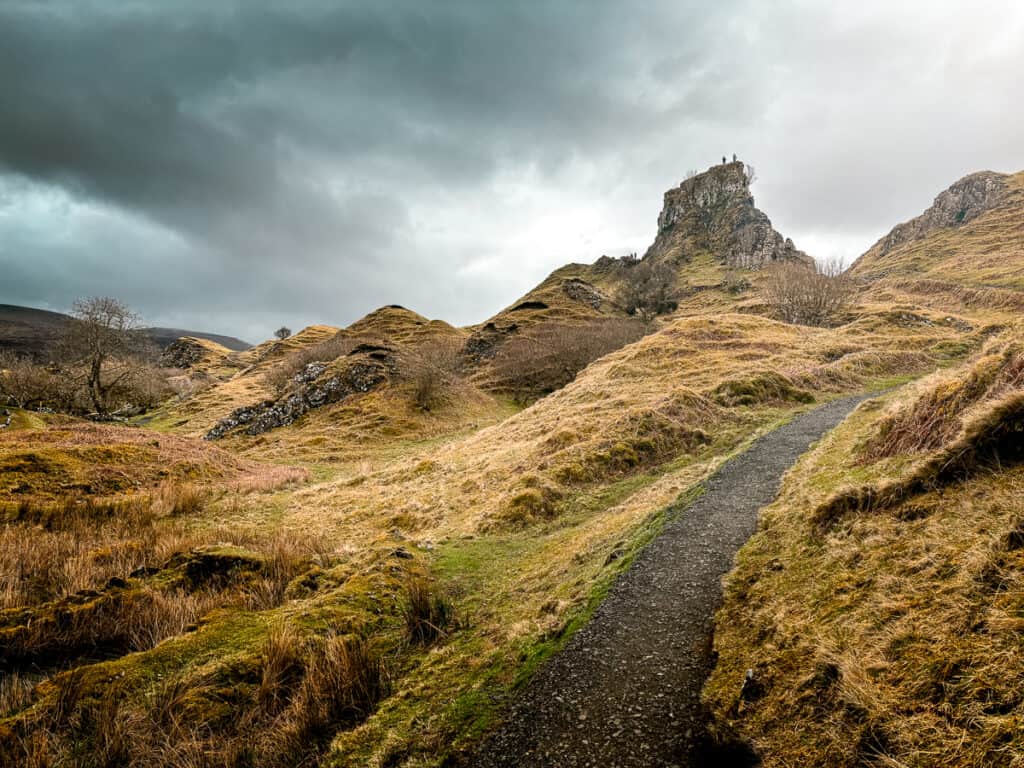
5. Neist Point Lighthouse
Location: Situated near the village of Glendale, Neist Point is the most westerly point on the Isle of Skye.
Neist Point Lighthouse is one of Scotland’s most iconic lighthouses, perched on the most westerly point of the Isle of Skye.
Built in 1909 by David Alan Stevenson, a member of the famous Stevenson family of lighthouse engineers, the lighthouse remains operational and continues to guide ships through the perilous waters, although it is not open to the public.
The area around Neist Point is renowned for its dramatic cliffs, rich marine wildlife, and breathtaking views over the Atlantic Ocean. It’s a prime location for spotting dolphins, whales, and a variety of seabirds.
It’s a long single-track road to get there, and it’s important not to get into a line of cars as it blocks the road when two lines meet and can’t get through the passing places, so hang back.
Hike Details: The walk to Neist Point is a 2.2 km (1.4 miles) round trip of moderate difficulty, featuring some steep sections and steps. The well-defined path offers stunning views and photographic opportunities, especially at sunset when the light casts a golden hue over the landscape. Due to the exposed nature of the path, caution is advised in windy conditions.
Facilities: Parking is available near the start of the trail, but it gets very busy, especially around sunset. There are no restrooms or other facilities on-site. Dunvegan Village car park has the nearest public restrooms.
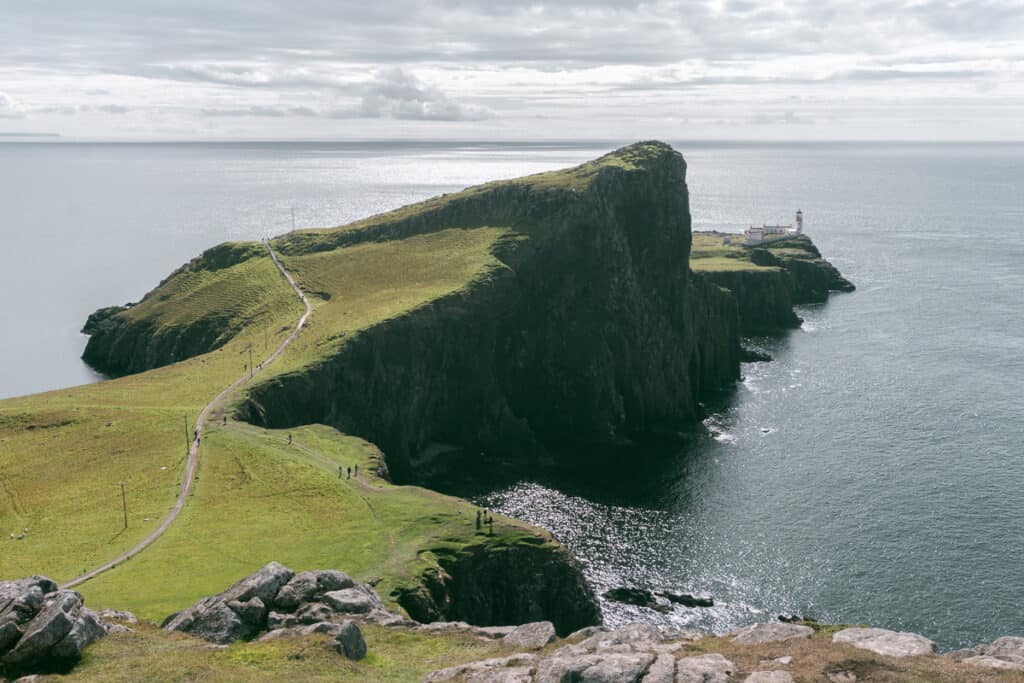
6. Mealt Falls and Kilt Rock
Location: Mealt Falls and Kilt Rock are located on the northeastern coast of the Trotternish Peninsula, approximately 15 kilometres (9 miles) north of Portree, near the village of Staffin.
Mealt Falls and Kilt Rock are two of the most striking natural attractions on the Isle of Skye and have long been a draw for tourists.
Mealt Falls is a dramatic waterfall that plunges 55 meters (180 feet) off the cliffs into the Sound of Raasay below. Loch Mealt, a nearby freshwater loch, feeds the waterfall.
Adjacent to Mealt Falls is Kilt Rock, a sea cliff resembling a pleated kilt. Vertical basalt columns and horizontal bands of dolerite characterise it. Together, these natural formations create a stunning coastal landscape that attracts photographers, nature enthusiasts, and tourists alike.
It’s a quick stop if you’re heading north to other attractions on the Trotternish Peninsula. From the viewing point you can enjoy views of Mealt Falls as it cascades over the cliff edge, especially when the wind catches the water, creating misty plumes.
Birdwatchers can often spot seabirds nesting on the cliffs, and during certain seasons, it’s possible to see dolphins and whales in the waters below.
Facilities: The viewpoint has a large pay-and-display parking area, with cars coming and going often. It costs £6 to park for the day using coins or contactless. The site has a small viewing platform with safety railings and informative plaques. There are no restrooms or other facilities.
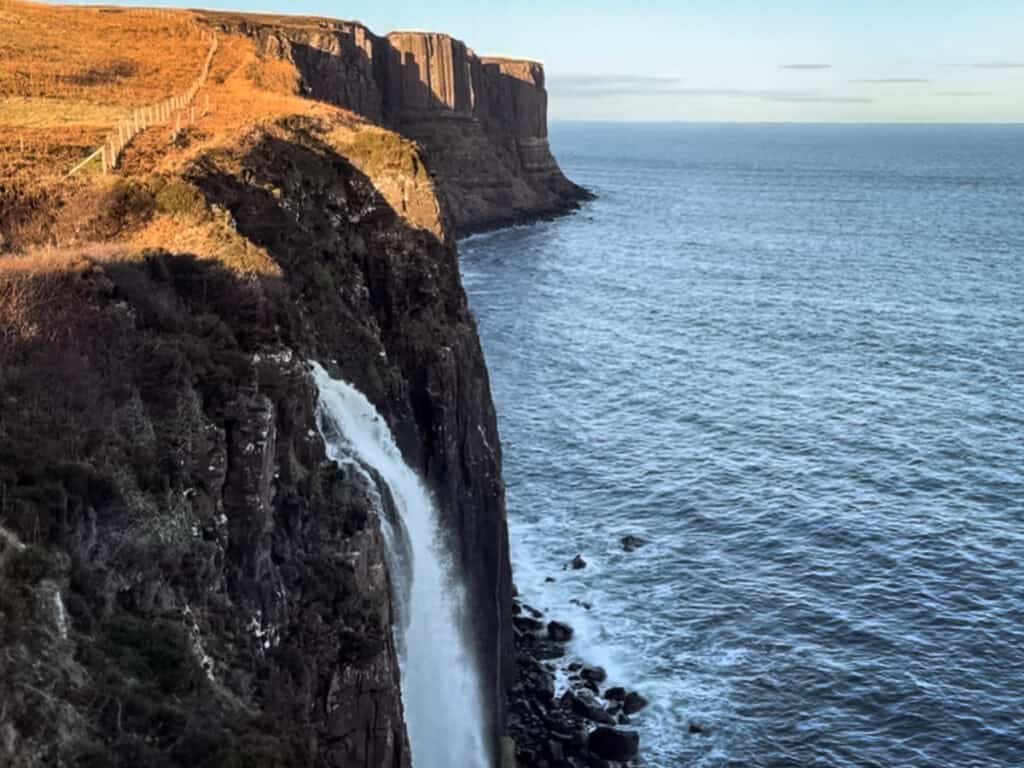
7. Dunvegan Castle & Gardens
Location: Located near the village of Dunvegan in the northwestern part of the Isle of Skye.
Dunvegan Castle is a treasure trove of history. It is the oldest continuously inhabited castle in Scotland and has been home to the Chiefs of Clan MacLeod for over 800 years.
Built in the 13th century, Dunvegan Castle has been continuously developed and expanded over the centuries, reflecting the changing tastes and fortunes of its inhabitants. The castle has played a significant role in Scottish history, including during the Jacobite uprisings when it served as a safe haven for Bonnie Prince Charlie.
The castle’s interior is richly decorated with antique furniture, paintings, and historical artefacts that tell the story of the MacLeod clan’s legacy.
It’s also home to the famous Fairy Flag, which is believed to have magical powers. You can read the various origin stories of the flag there, as some say it was gifted to the clan by fairies and others that it was brought back from somewhere in Syria or maybe even Rhodes.
The surrounding gardens, spread over five acres, are beautifully landscaped with a variety of plants and flowers.
Visitors can also take a boat trip from the castle to see the local seal colony and enjoy the stunning coastal views.
Cost:
Adult: £16.00
Child (5-15 yrs): £11.00
Concessions: £13.00
Family ticket (2 adults, 4 children): £37.00
Facilities: There is a large car park opposite the Castle, although it can get busy during peak season. There is also a gift shop, cafe, and restrooms. We enjoyed a fantastic venison stew at the cafe! Guided tours of the castle and boat trips are available at an extra cost.
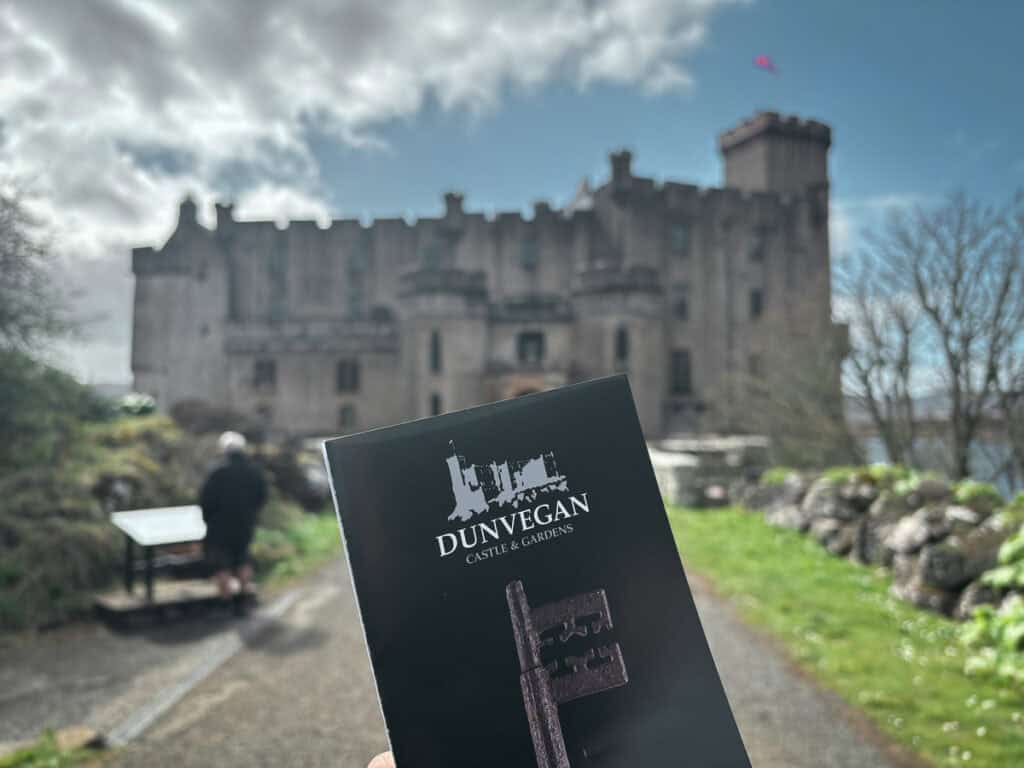
8. Talisker Distillery
Location: Located in Carbost, on the west coast of Skye.
Talisker Distillery, located on the shores of Loch Harport, is the oldest working distillery on the Isle of Skye and has the most visitors through it each year. It was founded in 1830 by Hugh and Kenneth MacAskill.
The distillery produces some of Scotland’s finest single malt whisky, known for its distinctive peaty and smoky flavour, which is influenced by the island’s rugged environment. The distillery’s location is part of its charm, offering stunning views of the surrounding landscape and contributing to the unique character of its whisky.
Guided tours of the distillery provide a detailed overview of the whisky production process, from malting and fermentation to distillation and maturation. Visitors can learn about the distillery’s history, the techniques used in production, and the unique qualities that make Talisker whisky stand out.
The tour concludes with a tasting session, where guests can sample a range of Talisker’s whiskies. The distillery also features a beautiful visitor centre with a well-stocked shop with exclusive bottlings and whisky-related merchandise.
Facilities: The distillery has a visitor centre, a gift shop, and restrooms. There is a new eatery nearby that is a collaboration with Three Chimneys Restaurant, which offers local cuisine and refreshments.
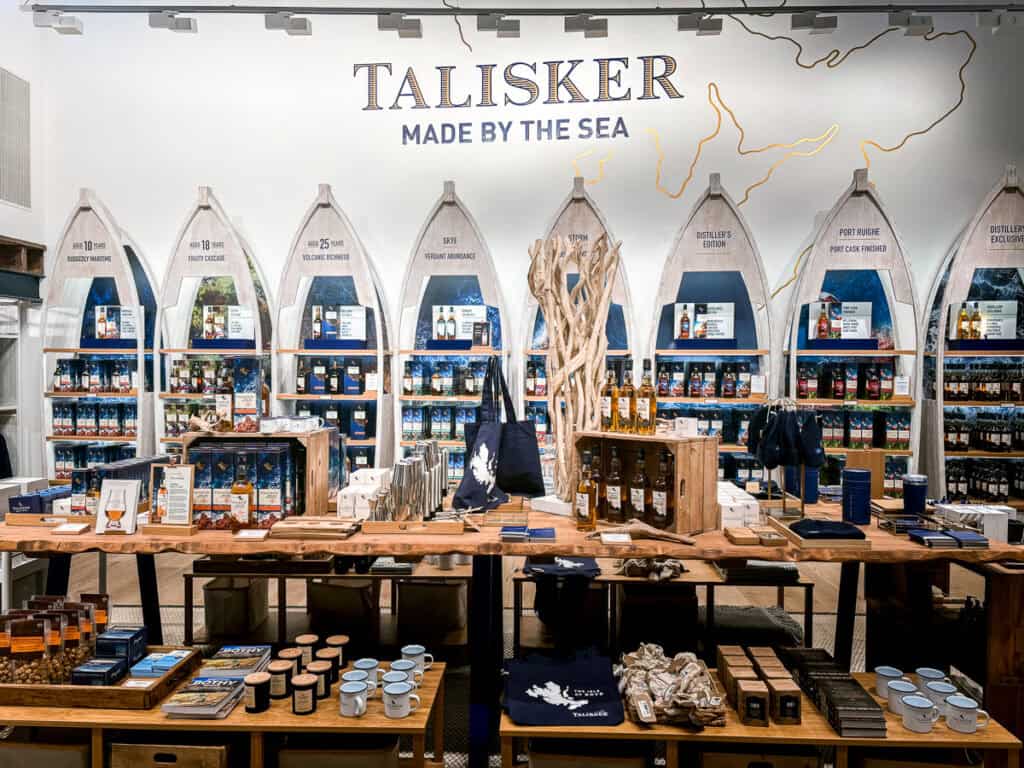
8. Armadale Castle and Gardens
Location: Located on the Sleat Peninsula, near the village of Armadale, the site offers stunning views across the Sound of Sleat.
Armadale Castle and Gardens is a historic site that combines natural beauty with rich cultural heritage. The castle was originally constructed in the early 19th century as the ancestral home of the Macdonald clan.
Although the castle is now in ruins, the beautifully landscaped gardens and woodlands surrounding it are well-maintained and feature exotic plants and trees from around the world.
The Museum of the Isles, located on the grounds, offers a deep dive into the history of the Macdonald clan and the cultural heritage of the Scottish Highlands and Islands.
Visitors can explore the castle ruins and stroll through the expansive gardens, which include a mix of formal gardens, woodland walks, a kids’ adventure playground, and scenic viewpoints.
While it’s not often listed in the top 5, it follows closely as the largest attraction in South Skye and is well worth the visit.
Facilities: Armadale Castle and Gardens offer parking, a cafe serving local fare, a gift shop with a selection of crafts and souvenirs, and restrooms. It’s an ideal stop in the south of Skye for those interested in history, gardens, and Scottish heritage.
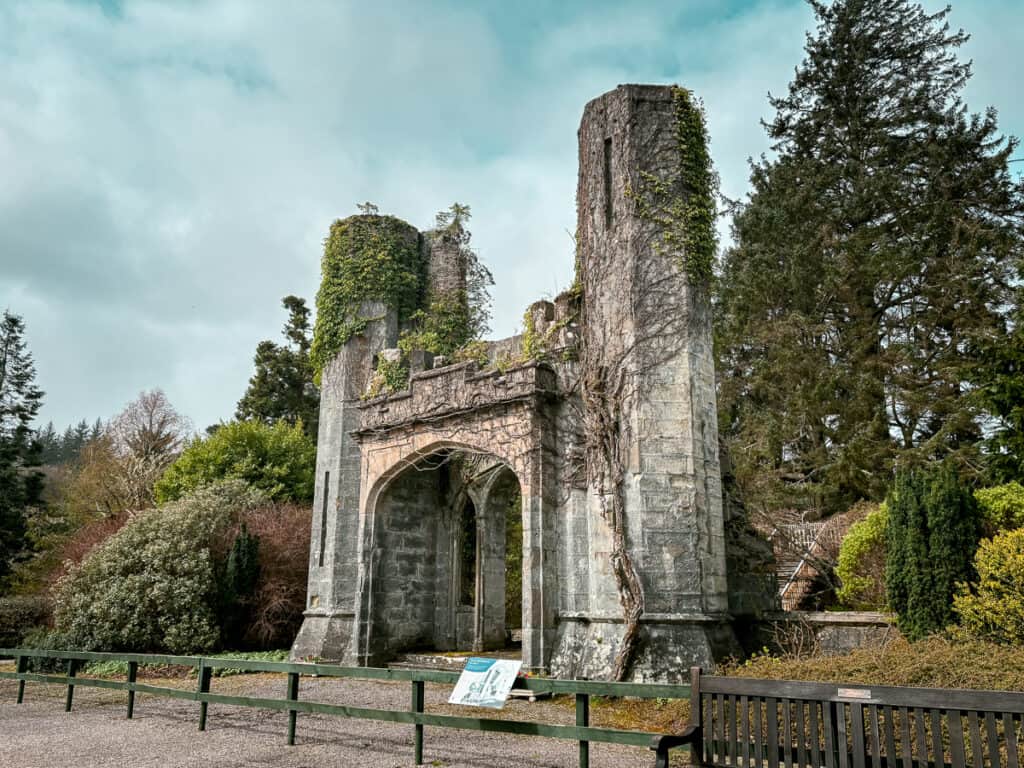
9. Sligachan
Location: Situated centrally on the Isle of Skye, it is easily accessible and well-connected to other parts of the island.
Sligachan is a picturesque area on the Isle of Skye known for its breathtaking scenery and historical significance.
It serves as a gateway to the Cuillin mountains, offering some of the island’s most dramatic and rugged landscapes.
Central to Sligachan is the historic Sligachan Old Bridge, built in the early 19th century and now an iconic landmark. The area is steeped in history and folklore, with many tales of the legendary Macleod and Macdonald clans.
Sligachan is a hub for outdoor enthusiasts, with numerous hiking trails leading into the Cuillin mountains. These trails range from easy walks along the river to challenging climbs into the peaks.
The Sligachan Hotel, established in 1830, offers a comfortable base for explorers, featuring cosy accommodations, a bar, and a restaurant serving local dishes.
Facilities: There is a small car park on the south side of the bridge, but it often fills quickly. The historic Sligachan Hotel offers accommodations and dining, but restrooms are for customers only.
Seumas’ Bar is famous for its extensive selection of whiskies, and the restaurant provides a warm and welcoming atmosphere after a day of exploring the surrounding wilderness.
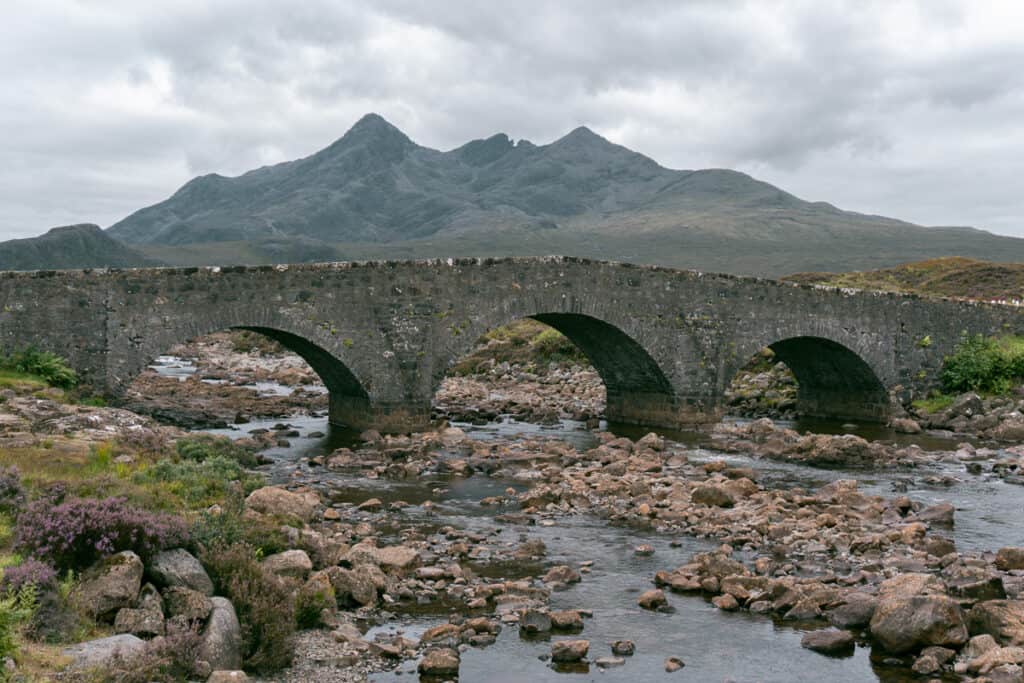
11. Dinosaur Footprints at An Corran
Location: When driving north, there is a turn-off for An Corran just after Staffin. The road is “Staffin Road,” which you follow to the right until you reach a car parking area.
The dinosaur footprints offer a unique and fascinating glimpse into the distant past of the Isle of Skye. Dating back approximately 170 million years to the Middle Jurassic period, they are among the best-preserved dinosaur tracks in Scotland. They would have been created when Skye was much warmer, and this area was a mud flat.
The footprints are believed to have been made by ornithopods, herbivorous dinosaurs, and theropods, carnivorous dinosaurs. They provide valuable insights into the island’s ancient ecosystem.
This isn’t normally in the top things in Skye but it’s a great one for families with kids to do!
You can explore the beach from mid to low tide to view the dinosaur footprints embedded in the rock just near the slipway.
The footprints are scattered across the rocky shore, and some are more distinct than others as they have become more eroded over time. It’s a fun and educational experience for all ages, allowing visitors to literally walk in the footsteps of dinosaurs.
Facilities: There is a parking area near the beach slipway, making it accessible for visitors. The site has an informational board but no actual markers of where the footprints are. We’d highly recommend a visit to the Staffin Dinosaur Museum first, so you know what you’re looking for and can get tips from the staff.
There are no restrooms or other facilities directly at the beach, but the nearby village of Staffin offers amenities such as restrooms, a small shop, and places to eat. Wear sturdy footwear suitable for walking on rocky and potentially slippery surfaces, and check tide times before visiting.
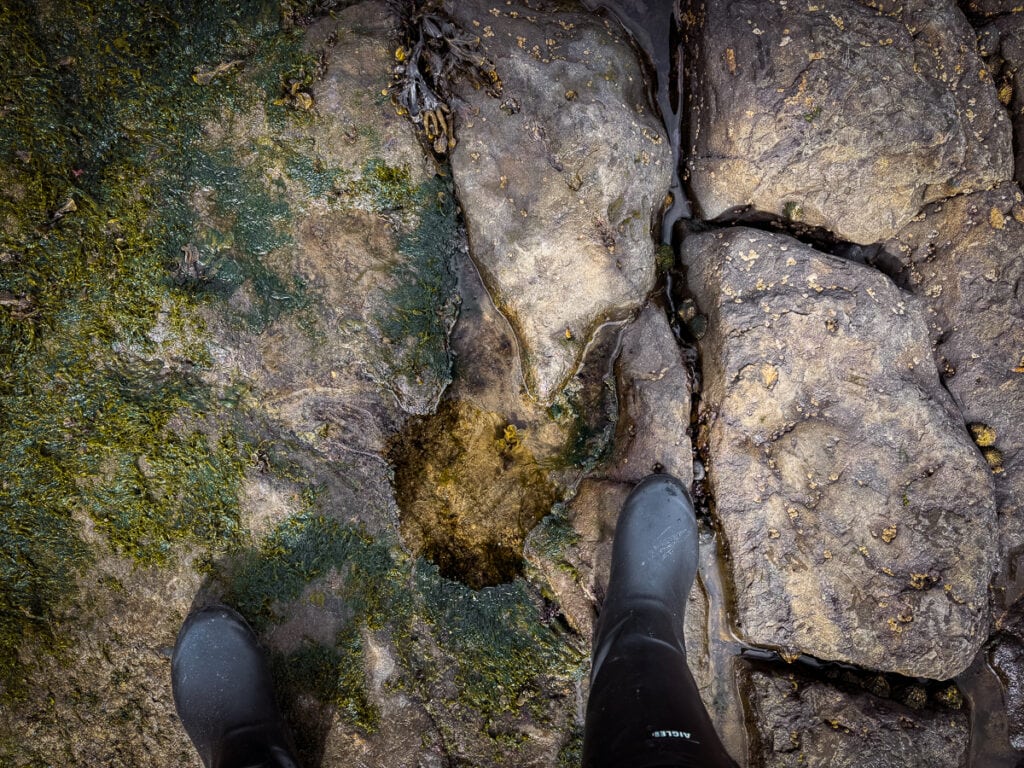
12. Lealt Falls
Location: Lealt Falls is located approximately 18 kilometers (11 miles) north of Portree, also on the Trotternish Peninsula. The falls are easily accessible from the A855 road.
Lealt Falls is a more recent addition to the top things to do on the Isle of Skye. A parking area and viewing platform have added it to the stops as you drive up the Trotternish Peninsula.
It is another magnificent waterfall set within a lush, green gorge. Lealt Falls is split into two main sections: the upper falls, which feature a series of cascades, and the lower falls, where the water plunges dramatically into a deep pool. The surrounding landscape is rich in history, with remnants of old diatomite works and crofting communities that once thrived in the area.
The upper viewpoint provides an excellent view of the cascading waters, while a path leading to the lower viewpoint offers a closer look at the powerful plunge pool. Informative signs explain the area’s history and geology, including the diatomite works’ industrial heritage.
Facilities: The site has a small parking area and a newly constructed viewing platform that provides safe and convenient access to the best views of the falls.
There are no restrooms or other amenities, so visitors should come prepared. The paths to the viewpoints are well-maintained but can be slippery when wet, so appropriate footwear is recommended.
13. The Skye Museum of Island Life
Location: Located in Kilmuir, in the north of Skye, the museum is set against the stunning backdrop of the island’s rugged landscape.
The Skye Museum of Island Life is often mentioned as a stop on a trip around the north of Skye. Although it would rarely feature in a top 5, we think it’s well worth taking the time to visit and learn more about life in the Skye.
Established in 1965, the museum features a collection of meticulously restored thatched cottages, each representing different aspects of island life. These cottages include the croft house, byre (barn), smithy (blacksmith’s workshop), and a ceilidh house, where community gatherings took place.
The museum’s exhibits display a vast array of artifacts, such as agricultural tools, fishing gear, household items, and clothing, providing a tangible connection to the past.
Facilities: The museum has a small gift shop offering local crafts and souvenirs, and restrooms are available on-site. Parking is provided for visitors.
As I mentioned, these 12 things are not the only things to do in Skye, although they make a great starting point for planning a trip.
If you only do these things, you’ll have a lovely time, but they are also popular, so you may not have a chance to escape and enjoy the tranquillity of the island. Try to find a few off-the-beaten-track things to do as well to really enhance your stay!
Sonja x
